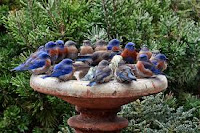The cost to sponsor a feeder station is $150.00, the materials to build the station is $50.00, leaving a donation of $100.00 to help feed the birds along the trail this coming nesting season.
All 25 Nest Boxes have been sponsored and 6 of the Feeder Stations have been sponsored by Friends of the Bluebird Trail.
We had a great year during 2013, with 20 Nest Boxes up and 1 Feeder Station. Hatching and fledgling 111 new baby birds, 100 that were Bluebirds, 6 Chickadee's and 5 Carolina/House Wrens.
So we hope this New Year 2014 will be even better with the trail having 25 nest boxes and 6 feeder stations up and operational.
If you have not already walked the Bluebird Trail, now is a good time to take a stroll along the easy to walk trail of 2.3 miles or less. The Green Meadows Preserve Parks Department will be cutting some new Trails in the near future, this will give us additional trails and distance that can be hiked in the preserve. This will also allow you to view more of the Nest Boxes and Feeder Station activity.
This picture is of my best friend and big supporter and someone who help's me a lot with the Bluebird Trail Walk and Talk Tours.We will be putting the spring schedule for our tours on the next blog in January. The spring tours will be awesome, as their will be much activity in Bluebirds house hunting and nest building along the trail.
This lake is one of our favorite hikes when we go to Colorado in the summer to get away from the Georgia heat. This best friend is my wife KC, who is a big fan of the Bluebird Trail.
We would like to say thank you to all those who have been supporter's of the Bluebird Trail this past year in your donation's, as well as those who have come out to join us during our Talk and Walk Tours. I would like to thank all my community garden friends and especially Mike and Sue Plumb for all their help in feeding the birds when I am out of town or after my foot surgery, when it was difficult for me to walk the trail.We would like to wish all of you a Merry Christmas and the very best during this beautiful Holiday Season.
Green Meadows Preserve Bluebird Trail, Where Birds come to Life!
Thanks for joining us along the Trail.....Jim B














.jpg)












 .
.



